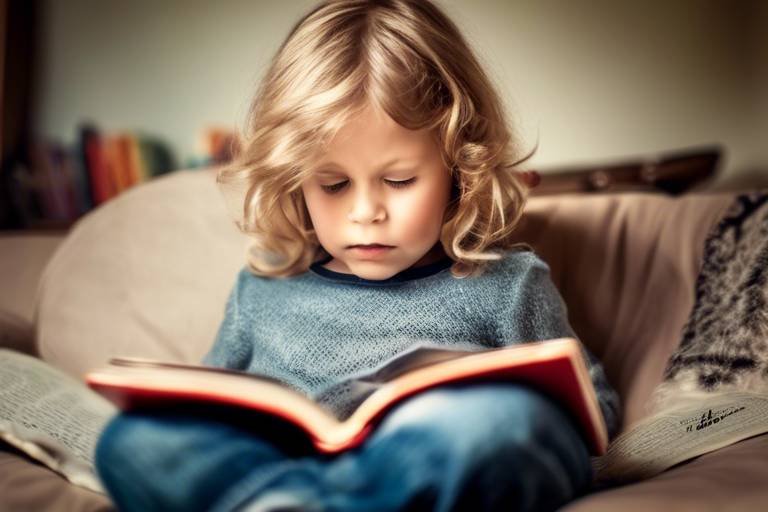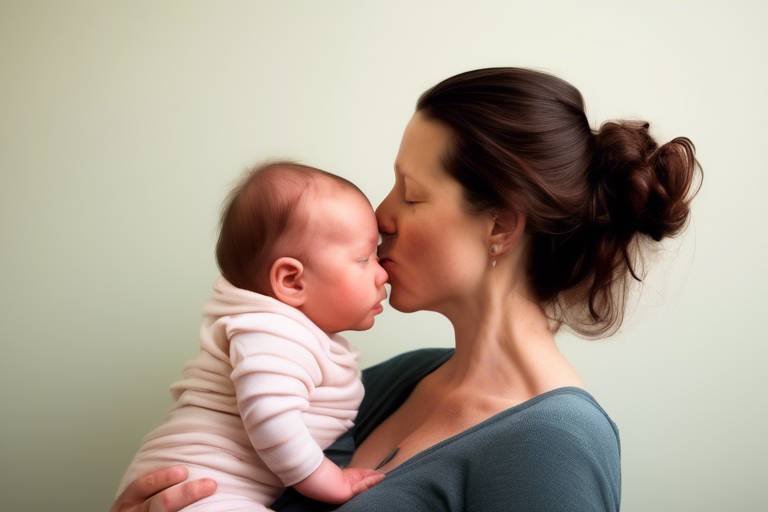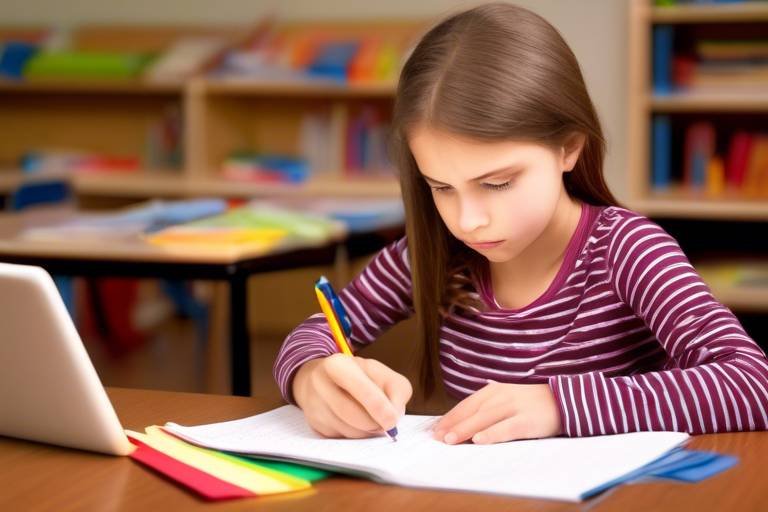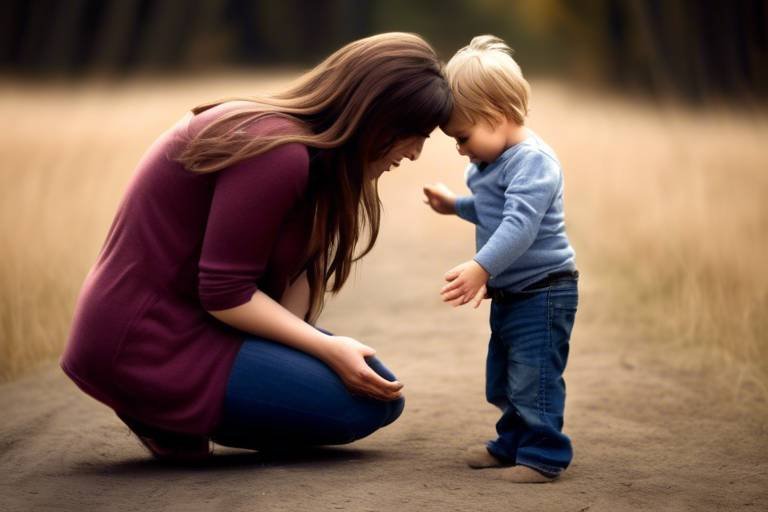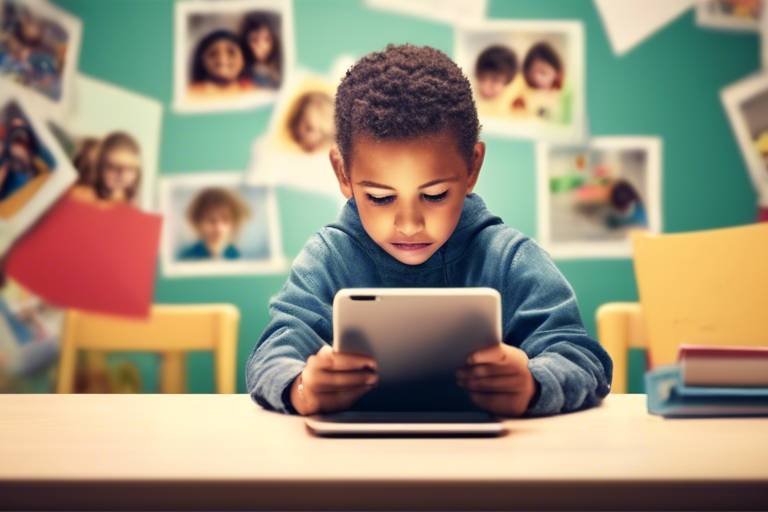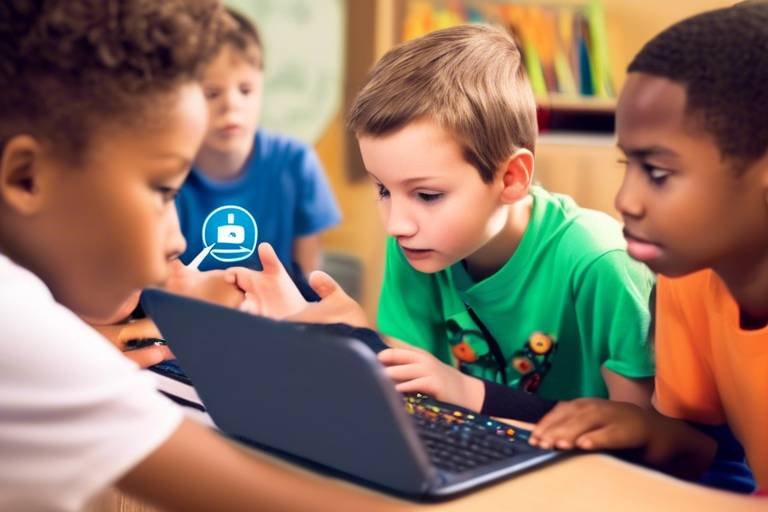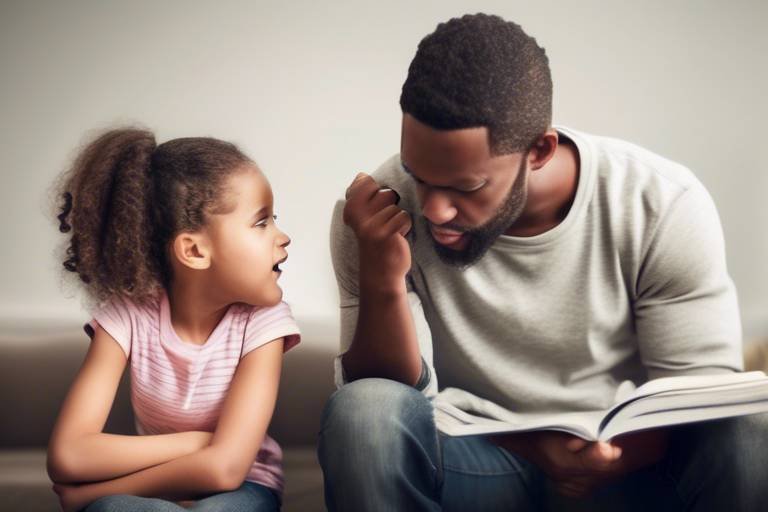Supporting Children Through the Divorce Process
Divorce can feel like an emotional earthquake, shaking the very foundation of a child's world. As parents, it’s our job to help them navigate through this tumultuous time, ensuring they feel secure and loved despite the changes. Understanding the challenges that children face during a divorce is crucial for providing the right support. This article explores effective strategies and insights to help children manage their emotions and adapt to new family dynamics.
Children often experience a whirlwind of emotions when their parents decide to separate. They may feel confused, angry, or even guilty, thinking they might have caused the divorce. It’s essential to recognize these feelings and validate them, letting children know it’s okay to feel this way. By creating an environment where they can express their thoughts and emotions freely, parents can help their children process these changes more effectively.
Moreover, the way parents communicate about the divorce plays a significant role in how children cope. Open conversations can help demystify the situation, offering reassurance and clarity. It’s important for parents to approach these discussions with empathy, using language that is age-appropriate and non-threatening. After all, children are like sponges, soaking up the emotions and attitudes of those around them. If parents remain calm and supportive, children are more likely to mirror that stability.
As we delve deeper into the emotional impact of divorce on children, we will also explore practical strategies for effective communication, co-parenting, and seeking professional support. The goal is to equip parents with the tools they need to foster resilience and emotional well-being in their children during this challenging transition.
Understanding the emotional ramifications of divorce is crucial for supporting children. This section delves into common feelings such as sadness, anger, and confusion, and how these emotions manifest in children. Children may express their feelings through changes in behavior, such as becoming withdrawn or acting out. Recognizing these signs is the first step in providing the necessary support.
Open and honest communication is key. Here, we discuss techniques for parents to communicate effectively with their children about divorce, fostering a safe space for expression and understanding. It's important to listen actively and encourage children to share their thoughts and feelings without judgment.
Children of different ages process divorce differently. This section highlights how to tailor conversations based on a child's developmental stage, ensuring they grasp the situation without unnecessary stress. For instance, younger children may need simple explanations, while older children might have more complex questions that require thoughtful answers.
Preschool-aged children may struggle with understanding the concept of divorce. This subsection offers tips on how to explain the situation simply and reassuringly. Using stories or drawings can be an effective way to help them visualize the changes in their family structure.
School-aged children often have more questions and concerns. This subsection provides guidance on addressing their specific worries and fostering emotional resilience during this time. It's essential to reassure them that both parents love them and that the divorce is not their fault.
Teaching children healthy coping strategies is essential. This section outlines various methods to help children manage their emotions, including art, play, and physical activity. Engaging in creative activities allows children to express their feelings in a non-verbal way, providing them with an outlet for their emotions.
Effective co-parenting can significantly influence a child's adjustment to divorce. This section discusses best practices for maintaining a cooperative relationship between parents for the child's benefit. When parents work together, it sends a powerful message to children that they are still a family, despite the changes.
Children thrive on stability. Here, we explore how establishing consistent routines between households can help children feel secure and supported during the transition. Routines can include regular meal times, bedtimes, and shared activities, which provide a sense of normalcy amidst the chaos.
Encouraging children to maintain relationships with both parents is vital. This subsection discusses strategies for ensuring children feel connected and valued by both sides of the family. Regular communication and shared experiences can help strengthen these bonds.
Sometimes, professional help is necessary. This section emphasizes the importance of therapy and counseling for children navigating the complexities of divorce, providing them with additional tools for coping. Professional support can offer a safe space for children to explore their feelings and develop healthy coping mechanisms.
Individual therapy can offer children a safe space to express their feelings. This subsection outlines the benefits and what to expect from therapy sessions. A trained therapist can provide valuable insights and strategies tailored to each child’s unique needs.
Family therapy can help improve communication and understanding among all family members. This subsection discusses how it can facilitate healing and strengthen relationships post-divorce. By working together in therapy, families can rebuild connections and foster a supportive environment.
Parents need access to resources that can assist them in supporting their children through divorce. This section lists books, websites, and organizations dedicated to helping families during this transition. Utilizing these resources can empower parents to make informed decisions and provide the best support for their children.
Literature can provide valuable insights. This subsection recommends specific books that address divorce from both a parent's and child's perspective, fostering understanding and empathy. Reading together can also be a bonding experience that encourages open dialogue.
Joining a support group can be beneficial for parents. This subsection highlights the importance of community and shared experiences in navigating the challenges of co-parenting after divorce. Connecting with others who understand the journey can provide comfort and practical advice.
Q: How can I help my child cope with the divorce?
A: Encourage open communication, validate their feelings, and provide consistent routines to help them feel secure.
Q: Should I talk to my child about the reasons for the divorce?
A: Yes, but keep it age-appropriate and avoid placing blame. Focus on reassuring them that they are not at fault.
Q: What if my child is struggling emotionally?
A: Consider seeking professional support, such as therapy, to help them process their emotions and develop coping strategies.

The Emotional Impact of Divorce on Children
Understanding the emotional ramifications of divorce is crucial for supporting children. When parents decide to separate, children often find themselves caught in a whirlwind of emotions that can be both overwhelming and confusing. It's not just about the end of a family unit; it's about the loss of stability and security that children have come to rely on. Many kids experience feelings of sadness, anger, and confusion, and it’s essential for parents to recognize these emotions and address them appropriately.
Children may express their feelings in various ways. Some may become withdrawn, while others might act out in frustration. It's important to understand that these behaviors are not just typical childhood responses; they are manifestations of deeper emotional struggles. For instance, a child might throw tantrums or refuse to go to school, which can be signs of their internal turmoil. Parents should be vigilant and observant, as these behaviors often serve as cries for help.
Additionally, the emotional impact of divorce can vary significantly based on a child's age and personality. Younger children might not fully understand what divorce means, leading to feelings of insecurity and fear about the future. On the other hand, older children might grapple with feelings of betrayal or guilt, often questioning whether they could have done something to prevent the separation. This emotional complexity requires a nuanced approach to support them effectively.
To further illustrate the emotional impact, consider the following table that outlines common emotional responses by age group:
| Age Group | Common Emotions | Potential Behaviors |
|---|---|---|
| Preschoolers (3-5 years) | Confusion, sadness | Clinginess, regression to earlier behaviors (e.g., bedwetting) |
| School-Aged Children (6-12 years) | Anger, anxiety, guilt | Acting out, withdrawal from friends, academic struggles |
| Teenagers (13-18 years) | Rebellion, deep sadness, frustration | Risky behavior, isolation, emotional outbursts |
Ultimately, the emotional impact of divorce on children is profound and can linger long after the initial separation. Parents must be proactive in addressing these feelings, providing a safe space for children to express themselves. This might involve open conversations about their feelings, reassurance that it’s okay to feel upset, and consistent emotional support. By acknowledging and validating their emotions, parents can help children navigate this challenging transition with greater resilience and understanding.
- How can I tell if my child is struggling with the divorce? Look for changes in behavior, such as increased irritability, withdrawal, or academic decline.
- Should I discuss the details of the divorce with my child? It's important to provide age-appropriate information without overwhelming them with adult issues.
- What if my child doesn't want to talk about their feelings? Encourage open dialogue but respect their space; sometimes, they may need time to process emotions.

Effective Communication Strategies
When it comes to navigating the choppy waters of divorce, effective communication is your lifebuoy. It’s not just about talking; it’s about creating a safe space for your children to express their feelings and concerns. Children often feel caught in the middle, and as a parent, it’s crucial to acknowledge their emotions. You might wonder, “How do I even start this conversation?” Well, the key lies in being open and honest, yet age-appropriate in your discussions.
One of the first steps is to ensure that your children know it’s perfectly okay to feel a whole range of emotions—sadness, anger, confusion, or even relief. You might say something like, “It’s normal to feel upset about the changes happening in our family.” This simple acknowledgment can go a long way in validating their feelings. Remember, children often look to their parents for cues on how to react. If you approach the situation with calmness and reassurance, they are likely to mirror that attitude.
Another effective strategy is to encourage questions. Kids are naturally curious, and they might have a million questions swirling in their minds. Instead of shying away from these inquiries, embrace them! You can say, “What are you thinking about? I’m here to help you understand.” This not only fosters open dialogue but also helps you gauge their understanding of the situation. You might find that some questions are simple, while others may require deeper conversations. It’s all part of the journey.
When discussing divorce, consider using age-appropriate language. For instance, preschoolers may not grasp complex concepts, so it’s best to keep things simple and straightforward. On the other hand, school-aged children can handle more detailed explanations. Here’s a quick breakdown:
| Age Group | Communication Tips |
|---|---|
| Preschoolers | Use simple language. Explain that sometimes adults live apart but still love their children. |
| School-Aged Children | Encourage questions. Discuss feelings openly and reassure them that it’s not their fault. |
| Teenagers | Respect their need for independence. Allow them to express their feelings and opinions. |
Moreover, it’s essential to maintain consistency in your messaging. If you and your co-parent can agree on the key points to communicate, it will help the children feel more secure. For instance, if one parent says, “We’re getting divorced, but we both love you,” the other parent should echo that sentiment. This unified front minimizes confusion and helps children process the changes more smoothly.
Lastly, don’t forget about non-verbal communication. Your body language, tone of voice, and even your facial expressions convey messages just as strongly as your words. If you’re feeling anxious or upset, your child will pick up on that. So, practice self-care, and try to be a calming presence. You might even consider setting aside time for family activities that foster connection, such as game nights or movie marathons. These moments can serve as a platform for lighter conversations where children feel more at ease to express their thoughts.
In summary, effective communication during a divorce is not a one-time conversation but an ongoing dialogue. By being open, encouraging questions, using age-appropriate language, maintaining consistency, and being mindful of non-verbal cues, you can help your children navigate this challenging time. They may not understand everything right away, but your support will provide them with a solid foundation to process their feelings.
- How can I tell my child about the divorce? It's best to keep the conversation simple and reassuring. Let them know that both parents love them and that it's okay to feel upset.
- What if my child has a lot of questions? Encourage them to ask anything they want. Be honest and provide answers that are appropriate for their age.
- How can I help my child cope with their feelings? Teach them healthy coping mechanisms like drawing, talking, or physical activities to express their emotions.
- Should I discuss the details of the divorce with my child? Avoid overwhelming them with adult issues. Focus on how the divorce affects their daily life instead.

Age-Appropriate Conversations
When it comes to discussing divorce with children, are essential. Children process information differently at various stages of their development, and understanding their unique perspectives can make a world of difference. For example, a preschooler might not grasp the permanence of divorce, while a school-aged child may have a myriad of questions and feelings about the situation. Tailoring your conversations to match their developmental stage is crucial in helping them navigate this emotional landscape.
For younger children, such as preschoolers, it’s important to keep explanations simple and straightforward. You might say something like, “Mommy and Daddy are going to live in different houses, but we both love you very much.” This kind of reassurance helps them feel safe and loved, even amidst the changes. Using visual aids or storytelling can also help convey complex emotions in a way they can understand. For instance, a story about a favorite character going through a similar situation can open the door for discussion without overwhelming them.
As children grow into the school-aged category, they often have more questions and a deeper understanding of relationships. It’s vital to encourage their curiosity while providing honest answers. You might consider asking them what they think about the situation first, which allows them to express their feelings and concerns. This approach not only validates their emotions but also fosters a sense of security, knowing that their thoughts and feelings matter. Here, it’s beneficial to discuss the changes in a way that emphasizes stability and love, perhaps even creating a visual schedule to outline what their routine will look like with both parents.
To further illustrate the differences in communication based on age, here’s a quick overview:
| Age Group | Key Considerations | Suggested Communication Techniques |
|---|---|---|
| Preschoolers (3-5 years) | Limited understanding of permanence; may fear abandonment | Simple explanations; use of stories and visuals |
| School-Aged Children (6-12 years) | More questions; can understand complex emotions | Encourage dialogue; validate feelings; provide honest answers |
| Teenagers (13+ years) | Higher emotional complexity; may feel anger or resentment | Open discussions; encourage independence; respect their feelings |
For teenagers, the conversation shifts again. They are likely to grapple with more intense emotions, such as anger or confusion, and may even feel the need to take sides. It’s crucial to maintain an open line of communication, allowing them to express their feelings freely without judgment. Instead of offering solutions right away, consider asking them how they feel about the divorce and what they think it means for their future. This not only empowers them but also fosters a sense of maturity and understanding.
Ultimately, the goal is to create a safe space for your child to express themselves, no matter their age. By tailoring your conversations to their developmental stage, you’re not just helping them understand the situation better; you’re also instilling a sense of security and love during a tumultuous time. Remember, it’s not just about what you say, but how you say it, and the love that underpins every conversation.
Q: How can I tell if my child is struggling with the divorce?
A: Look for signs such as changes in behavior, withdrawal from activities, or increased anxiety. It’s essential to maintain open communication and check in regularly with your child about their feelings.
Q: Should I involve my child in discussions about custody arrangements?
A: While it’s important to keep your child informed, be mindful of the level of detail you provide. Focus on reassuring them and maintaining stability rather than overwhelming them with adult concerns.
Q: How can I help my child cope with their feelings about the divorce?
A: Encourage healthy coping mechanisms, such as art, journaling, or physical activities. Providing a supportive environment where they can express their emotions is crucial.

Preschoolers and Divorce
When it comes to preschoolers, the concept of divorce can be as bewildering as trying to explain why the sky is blue to a toddler. At this age, children are just beginning to grasp the world around them, and the idea that their family structure is changing can be both frightening and confusing. It's essential for parents to approach this topic with a gentle touch, using simple language and reassuring tones. Preschoolers often have a limited understanding of relationships and may not fully comprehend what divorce means. They might think that one parent is simply going on a long trip or that they are to blame for the situation.
To help preschoolers navigate this emotional landscape, parents can utilize a few effective strategies. First, it’s crucial to communicate that both parents love them and that this love will not change, regardless of the circumstances. Using phrases like, “Mommy and Daddy are going to live in different houses, but we both love you very much,” can provide comfort and clarity. Visual aids, such as drawings or storybooks about divorce, can also be beneficial. These tools can help children visualize and understand what is happening in a way that is less intimidating.
Another effective method is to encourage open expression of feelings. Preschoolers may not have the vocabulary to articulate their emotions, so parents should create a safe space for them to express themselves through play or art. Activities like drawing pictures of their family or playing with dolls can serve as a conduit for their feelings, allowing them to process their emotions in a non-verbal way. It’s also important to watch for signs of distress, such as changes in behavior, sleep disturbances, or excessive clinginess, which can signal that a child is struggling to cope.
Furthermore, maintaining routines can provide a sense of stability that preschoolers desperately need during this tumultuous time. Consistent meal times, bedtimes, and playdates can help create a reassuring environment where children feel secure. Parents should also strive to keep transitions between homes as smooth as possible, perhaps by having a special goodbye ritual or a comforting item that travels between households. These small gestures can make a world of difference in how preschoolers perceive and adapt to the changes in their family dynamics.
Ultimately, while the journey through divorce is undoubtedly challenging for preschoolers, with love, patience, and understanding, parents can help their little ones navigate this transition with a sense of safety and emotional security. Remember, it’s not just about explaining what divorce means; it’s about ensuring that preschoolers feel loved and supported every step of the way.
- How can I explain divorce to my preschooler? Use simple language and reassure them that both parents love them. Visual aids can also help.
- What signs should I look for in my child? Look for changes in behavior, such as increased clinginess, sleep issues, or emotional outbursts.
- How can I help my child cope? Encourage expression through play and maintain consistent routines to provide stability.
- Is it okay for my child to feel angry or sad? Absolutely, these emotions are normal. Validate their feelings and provide a safe space for them to express themselves.

School-Aged Children and Divorce
When it comes to school-aged children and divorce, the emotional landscape can be particularly complex. Unlike preschoolers, who may struggle to grasp the concept of divorce, school-aged children are often more aware of the dynamics at play. They may have a plethora of questions swirling in their minds, ranging from "Why is this happening?" to "Will I still see both my parents?" These questions can stir up feelings of confusion, anger, and even guilt, making it essential for parents to approach the situation with sensitivity and openness.
It's crucial for parents to create an environment where children feel safe to express their emotions. One effective way to do this is through active listening. When a child shares their feelings or concerns, parents should validate those emotions by acknowledging them. For example, saying something like, "It's okay to feel sad about this," can help children understand that their feelings are normal and accepted. This not only fosters emotional resilience but also strengthens the parent-child bond during a tumultuous time.
Moreover, using age-appropriate language is vital. School-aged children are often at a stage where they can comprehend more complex concepts, but they still need guidance. Parents should aim to explain the situation in a way that is honest yet reassuring. For instance, instead of saying, "We're getting a divorce because we don't love each other anymore," it might be more beneficial to say, "Sometimes, adults find it hard to live together, but that doesn't change how much we love you." This reframing can help children feel more secure and less responsible for the changes happening around them.
Additionally, school-aged children might benefit from engaging in activities that help them process their feelings. Encouraging them to express their emotions through art, writing, or even physical activities can be incredibly therapeutic. For example, drawing a picture of their family or writing a letter to one parent can provide a constructive outlet for their feelings. Parents can also consider setting up regular family meetings to check in on how everyone is feeling, which can foster a sense of unity and support.
In summary, navigating divorce with school-aged children requires a thoughtful approach that emphasizes open communication and emotional support. By actively listening, using age-appropriate language, and encouraging creative expression, parents can help their children process this significant life change while ensuring they feel loved and valued.
- How can I tell my child about the divorce? It's best to be honest yet gentle. Use simple language and reassure them that both parents will continue to love and support them.
- What should I do if my child is acting out after the divorce? Understand that this behavior is often a response to their feelings. Encourage open dialogue about their emotions and seek professional help if needed.
- How can I help my child maintain a relationship with both parents? Facilitate regular contact through phone calls, video chats, or scheduled visits, ensuring that your child knows both parents are there for them.

Encouraging Healthy Coping Mechanisms
When it comes to helping children navigate the stormy seas of divorce, is crucial. Just like a ship needs a sturdy sail to weather a storm, children need effective tools to manage their emotions during this challenging time. So, how can we equip them with these tools? Well, it starts with understanding that every child is unique and will respond differently to stress. Some may express their feelings openly, while others might bottle them up. That’s why it’s essential to create an environment where they feel safe to express themselves.
One of the most effective ways to help children cope is through creative outlets. Activities such as drawing, painting, or crafting can serve as a powerful means for children to express what they’re feeling inside. Just imagine a child pouring their heart onto a canvas; it’s like giving them a voice when they might not have the words. Additionally, engaging in play can also be therapeutic. Whether it’s through role-playing or imaginative games, children can process their experiences in a way that feels safe and manageable.
Physical activity is another fantastic coping mechanism. It’s not just about keeping them busy; exercise releases endorphins, which are natural mood lifters. Whether it’s a game of soccer in the backyard or a dance party in the living room, moving their bodies can help children feel more grounded and less overwhelmed. It’s like turning on a light in a dark room; suddenly, everything feels a bit more manageable.
Furthermore, teaching children mindfulness techniques can be incredibly beneficial. Simple practices like deep breathing or meditation can help them center themselves when emotions run high. For instance, you can encourage them to take a few deep breaths whenever they feel anxious or upset. This not only helps them in the moment but also gives them a valuable skill they can use throughout their lives.
Finally, it’s important to recognize when a child might need additional support. Sometimes, despite our best efforts, children may struggle to cope with their feelings. In such cases, seeking help from a therapist can provide them with tailored strategies to manage their emotions effectively. It’s like having a personal coach guiding them through their emotional journey, ensuring they have the right tools to succeed.
In summary, encouraging healthy coping mechanisms involves a mix of creative expression, physical activity, mindfulness, and professional support. By providing children with these tools, we can help them not only survive the emotional waves of divorce but also thrive in the aftermath. Remember, it’s all about creating a safe space for them to explore their feelings and learn how to navigate their emotions with confidence.
Q: How can I tell if my child is struggling with the divorce?
A: Look for signs such as changes in behavior, withdrawal from activities they once enjoyed, or increased anxiety. Open communication is key; ask them how they feel and listen actively.
Q: What if my child doesn't want to talk about their feelings?
A: That’s perfectly normal! Encourage them to express themselves through art or play. Sometimes, children communicate better through creative outlets rather than direct conversation.
Q: Should I seek professional help for my child?
A: If you notice persistent signs of distress or if your child is struggling to cope, it’s a good idea to consult a therapist. Professional guidance can provide valuable support tailored to your child’s needs.

The Role of Co-Parenting
Co-parenting plays a crucial role in how children adjust to the changes brought about by divorce. When parents can work together amicably, it sets a positive tone for their children. Imagine a ship navigating through stormy seas; if both captains (the parents) are on the same page, the ship will sail much more smoothly. On the contrary, conflicting directions can lead to chaos, confusion, and emotional distress for the little ones on board. It’s essential for parents to prioritize their child's well-being above all else, fostering a cooperative environment that nurtures stability and love.
One of the most important aspects of effective co-parenting is communication. Parents should maintain open lines of dialogue, not just with each other but also with their children. This means discussing schedules, sharing important updates, and making decisions together. When children see their parents collaborating, it reassures them that, despite the changes, they are still supported by both sides. A well-coordinated approach helps eliminate the feelings of being caught in the middle, which can be emotionally taxing for kids.
Creating consistent routines across both households is another vital element of co-parenting. Children thrive on predictability, and having a structured environment can significantly help them feel secure. For instance, if bedtime is set for 8 PM in one house, it should ideally be the same in the other. This consistency not only provides a sense of normalcy but also reinforces the idea that both parents are working together for their child's best interest. It’s like a well-rehearsed dance; when both partners know their steps, the performance is harmonious and enjoyable.
Furthermore, fostering positive relationships with both parents is essential. Children should feel free to express their love for each parent without fear of judgment or guilt. This can be achieved by encouraging them to share experiences, stories, and emotions related to each parent. For instance, if a child has a special memory with one parent, they should feel comfortable sharing it with the other. Such openness not only strengthens the child's bond with both parents but also promotes a healthy emotional environment.
In summary, co-parenting is about collaboration, communication, and consistency. The more parents can work together, the more secure and supported their children will feel during this tumultuous time. By focusing on these principles, parents can help their children navigate the waters of divorce with greater ease and resilience.
- What is co-parenting? Co-parenting refers to the shared responsibility of raising children by two parents who may not be in a romantic relationship anymore.
- How can co-parenting benefit my child? Effective co-parenting can provide emotional stability, reduce anxiety, and foster a sense of security for children during a divorce.
- What are some common challenges in co-parenting? Challenges may include communication issues, differing parenting styles, and emotional conflicts between parents.
- How can I improve co-parenting with my ex? Focus on open communication, establish consistent routines, and prioritize your child's needs to create a cooperative environment.

Creating Consistent Routines
When it comes to supporting children through the tumultuous waters of divorce, one of the most effective anchors you can provide is a consistent routine. Think of routines as a comforting lighthouse in a stormy sea; they offer stability and predictability, which can be incredibly reassuring for children who may feel like their world is upside down. Establishing a routine helps children understand what to expect from day to day, which can significantly reduce anxiety and confusion.
Children thrive on structure, and having a clear schedule can help them feel more secure. This is especially important when they are transitioning between two homes. Here are a few key aspects to consider when creating consistent routines:
- Daily Activities: Establish regular times for meals, homework, play, and bedtime. When children know what comes next, they can focus on enjoying each moment rather than worrying about what might happen.
- Communication: Keep an open line of communication between both parents regarding the routine. This ensures that children receive the same messages and expectations from both sides, reducing confusion.
- Flexibility: While consistency is key, it’s also important to be flexible. Life can be unpredictable, and showing children that it’s okay to adapt can be a valuable lesson in resilience.
One effective way to implement routines is to create a visual schedule that can be displayed in both homes. This can be as simple as a colorful chart that outlines daily activities, or even a digital calendar that both parents can access. Visual aids can help children, especially younger ones, grasp the concept of time and what to expect throughout the day.
It's also crucial to involve children in the process of creating their routines. Ask for their input on what activities they enjoy and when they prefer to do them. This not only empowers them but also gives them a sense of control during a time when they might feel helpless. For example, if a child loves reading before bed, including that as a nightly ritual can provide comfort and a sense of normalcy.
Another important element of consistency is maintaining similar rules and expectations across both households. If one parent allows later bedtimes while the other enforces an earlier one, this inconsistency can lead to confusion and frustration. By aligning on key aspects such as discipline and privileges, both parents can create a unified front that helps children feel more secure.
In conclusion, creating consistent routines is not just about scheduling; it's about building a framework of support that helps children navigate the complexities of divorce. By providing structure, maintaining open communication, and involving children in the process, parents can foster a sense of stability that is crucial for their emotional well-being during this challenging time.
- Why are routines important for children during a divorce?
Routines provide stability and predictability, helping children feel secure during a time of uncertainty. - How can I create a routine that works for both households?
Communicate openly with your co-parent to align on key activities and rules, ensuring a consistent experience for your child. - What if my child resists the routine?
Involve your child in the creation of the routine to give them a sense of control and ownership, making them more likely to embrace it.

Fostering Positive Relationships
When parents go through a divorce, one of the most crucial aspects to consider is how to maintain and foster positive relationships between children and both parents. It’s essential to ensure that children feel connected and valued by both sides of the family. After all, children thrive on love and support, and the absence of one parent can lead to feelings of abandonment or insecurity.
First and foremost, it’s vital to encourage open communication between children and both parents. This means actively listening to what children have to say about their feelings regarding the divorce and their relationship with each parent. By creating a safe space for dialogue, children will feel more comfortable sharing their thoughts and emotions. It’s like building a bridge; the more you communicate, the stronger that bridge becomes, allowing for a smoother connection.
Additionally, parents should avoid speaking negatively about each other in front of the children. This can create a sense of loyalty conflict, where the child feels torn between two parents. Instead, focus on the positive attributes of the other parent. For example, if one parent is an excellent cook, the other can highlight that skill when discussing family meals. This approach not only reinforces the child’s bond with both parents but also models respect and maturity in handling difficult situations.
Another effective strategy is to establish regular visitation schedules that allow for quality time with both parents. Consistency is key here. Children should know when they will see each parent, and having a predictable routine can provide a sense of stability amidst the chaos of divorce. Consider using a calendar to visually represent the schedule, helping children understand and anticipate their time with each parent.
Engaging in shared activities can also strengthen the bond between children and both parents. Whether it’s a weekend outing to the park, attending a sports game, or simply cooking dinner together, these experiences can create lasting memories. As a parent, participating in your child’s interests shows that you care about their happiness. It’s like planting seeds in a garden; the more you nurture these relationships, the more they will flourish.
Lastly, it’s important to encourage children to maintain relationships with extended family members on both sides. Grandparents, aunts, uncles, and cousins can provide additional support and love, creating a broader network of stability. Make an effort to facilitate visits and interactions with these family members, as it can help children feel more grounded during this transitional period.
- How can I encourage my child to express their feelings about the divorce? Create a safe space for them to talk, perhaps during a calm moment or while engaging in a fun activity. Ask open-ended questions to invite dialogue.
- What if my ex-partner is not cooperative in fostering a positive relationship? Focus on what you can control. Maintain a positive attitude and continue to encourage your child’s relationship with their other parent, regardless of the circumstances.
- How can I help my child feel secure in both homes? Establish consistent routines and rules in both households. This can help children adjust to the changes while feeling a sense of normalcy.

Seeking Professional Support
As parents navigate the stormy waters of divorce, it’s essential to recognize that sometimes, the best way to support your child is by seeking professional help. Divorce can be a whirlwind of emotions, and children might not always have the tools to process what they’re feeling. This is where therapy and counseling come into play, acting as a lifebuoy in turbulent seas. Professional support offers children a safe space to express their feelings, fears, and confusion, which can be incredibly beneficial for their emotional health.
Individual therapy can be particularly impactful for children. In these sessions, they can talk about their experiences and feelings without the pressure of worrying about their parents’ emotions. A trained therapist can help children understand their feelings better and develop healthy coping mechanisms. For instance, children might learn to articulate their emotions through play therapy, where they can express themselves through toys and games, making it easier for them to communicate their thoughts.
Family therapy is another excellent option that can help bridge the communication gap that often widens during a divorce. This approach allows all family members to come together in a structured environment, promoting understanding and healing. Family therapists can facilitate discussions that may be too difficult to have on your own, helping to mend relationships and foster a sense of unity. It’s an opportunity for parents and children to address their feelings collectively, reinforcing that they’re all in this together.
When considering professional support, it’s crucial to find a therapist who specializes in children’s issues related to divorce. Look for someone who is not only qualified but also has experience working with families in similar situations. Here are a few things to keep in mind when selecting a therapist:
- Credentials: Ensure the therapist is licensed and has experience in child psychology.
- Specialization: Look for someone who specializes in family dynamics and divorce-related issues.
- Approach: Consider the therapeutic approach they use and whether it aligns with your child's needs.
In conclusion, seeking professional support can be a game-changer for children dealing with the complexities of divorce. It not only provides them with tools to cope but also fosters an environment where they can heal and thrive. Remember, reaching out for help is not a sign of weakness; it’s a proactive step towards ensuring your child’s emotional well-being during this challenging time.
Q1: How do I know if my child needs therapy after a divorce?
A1: Look for signs such as changes in behavior, increased anxiety, withdrawal from friends or activities, or difficulty expressing emotions. If you notice these signs, it might be beneficial to consult a professional.
Q2: What can I expect from individual therapy for my child?
A2: Individual therapy typically involves discussions about feelings and experiences, often using play therapy techniques to help children express themselves. The therapist will work to build trust and create a safe environment for your child.
Q3: How can family therapy help my family?
A3: Family therapy can improve communication between family members, address unresolved issues, and provide a platform for everyone to express their feelings. It can strengthen family bonds and promote healing.
Q4: Are there any resources I can use to find a therapist?
A4: Yes! Websites like Psychology Today and TherapyDen allow you to search for therapists based on your needs, location, and insurance. Additionally, local community centers may have resources or referrals.

Individual Therapy for Children
When it comes to navigating the emotional labyrinth of divorce, individual therapy can be a game changer for children. Imagine a safe haven where they can express their feelings without the fear of judgment—this is what therapy offers. Children often grapple with a whirlwind of emotions, and having a dedicated space to unpack these feelings can be incredibly beneficial. In therapy, children learn to articulate their thoughts, which can be especially empowering during such a tumultuous time.
One of the key benefits of individual therapy is that it provides children with tools to cope with their emotions. They can learn techniques such as deep breathing, mindfulness, and even creative expression through art or play. These skills can help them manage feelings of sadness, anger, and confusion that often accompany divorce. Moreover, therapy can help children understand that their feelings are valid and that it's okay to seek help when they feel overwhelmed.
Parents often wonder what to expect from therapy sessions. Typically, the first few sessions may involve the therapist getting to know the child, establishing trust, and understanding their unique situation. As the child becomes more comfortable, they will have the opportunity to delve deeper into their emotions and experiences. This process can be incredibly cathartic, as children learn to navigate their feelings and develop healthier coping mechanisms.
It's also worth noting that therapy isn't just about addressing negative emotions. It can also be a space for children to explore their hopes and dreams for the future. They can discuss their fears about the changes in their family dynamic and even set personal goals for themselves. By focusing on both emotional healing and personal growth, therapy can provide a comprehensive support system for children during this challenging time.
In summary, individual therapy can be a vital resource for children dealing with the aftermath of divorce. It equips them with essential coping strategies, fosters emotional expression, and creates a supportive environment for personal growth. If you're considering therapy for your child, it's important to choose a therapist who specializes in working with children, as they will be better equipped to address the unique challenges your child may face.
- How do I know if my child needs therapy? If your child is showing signs of distress, such as changes in behavior, withdrawal, or excessive anger, it may be time to consider therapy.
- What should I look for in a therapist? Look for a therapist who specializes in child psychology and has experience dealing with issues related to divorce.
- How long does therapy usually last? The duration of therapy can vary widely based on the child's needs, but many children benefit from several weeks to months of regular sessions.
- Will my child talk about their feelings in therapy? Yes, the aim of therapy is to create a safe space where children feel comfortable expressing their emotions.

Family Therapy as an Option
When navigating the tumultuous waters of divorce, it's not just the couple that feels the impact; the entire family dynamic can shift dramatically. This is where family therapy emerges as a beacon of hope. It serves as a platform where each family member can voice their feelings, concerns, and fears in a safe and structured environment. Imagine it like a family meeting, but with a trained facilitator who helps steer the conversation in a constructive direction. The aim is to foster understanding and healing, allowing family members to reconnect amidst the chaos.
Family therapy offers several benefits that can be pivotal for families dealing with the aftermath of a divorce. For starters, it allows for open dialogue. Often, children may feel caught in the middle, unsure of how to express their emotions without hurting either parent. In therapy, they can articulate their feelings, which can lead to a better understanding among all family members. It's like giving them a voice in a situation where they might feel voiceless.
Moreover, family therapy can help in identifying and addressing underlying issues that may have contributed to the divorce. Sometimes, the problems run deeper than just the relationship between the parents. Perhaps there are communication barriers, unresolved conflicts, or even behavioral issues in children that need attention. A therapist can guide the family in uncovering these layers, making it easier to work through them together.
Another significant advantage is the development of coping strategies. Divorce can be a whirlwind of emotions, and having a professional help the family learn how to cope can be invaluable. During therapy sessions, families can explore various techniques for managing stress, improving communication, and building resilience. This can be a game-changer, especially for children, as they learn how to navigate their feelings in a healthy way.
It's essential to note that family therapy isn't about placing blame or rehashing old arguments. Instead, it's about creating a supportive environment where healing can take place. The therapist acts as a neutral party, ensuring that everyone feels heard and respected. This can be incredibly beneficial for children, who often feel torn between their parents. By participating in therapy, they can see that both parents are committed to their well-being, even if they are no longer together.
In conclusion, family therapy can be a powerful tool in the healing process post-divorce. It encourages open communication, addresses underlying issues, and equips families with coping strategies. If you're considering this option, remember that the goal is to emerge stronger and more connected as a family unit, despite the changes. Just as a ship needs a skilled captain to navigate through stormy seas, families can benefit from the guidance of a trained therapist to help them sail through this challenging time.
- What is family therapy? Family therapy is a type of psychological counseling that helps family members improve communication and resolve conflicts.
- How can family therapy help after a divorce? It can facilitate open dialogue, help identify underlying issues, and teach coping strategies for all family members.
- Is family therapy suitable for all ages? Yes, family therapy can be tailored to suit all ages, ensuring that everyone has a voice in the process.
- How long does family therapy typically last? The duration can vary based on the family's needs, but sessions usually last from a few weeks to several months.

Resources for Parents
When navigating the turbulent waters of divorce, parents often find themselves in need of guidance and support. Thankfully, there are numerous resources available to assist parents in helping their children through this challenging transition. These resources can provide valuable insights, practical advice, and emotional support to ensure that both parents and children can cope effectively with the changes in their family dynamics.
Books can be an excellent starting point for parents looking to understand the emotional landscape of divorce. They offer perspectives from both adults and children, helping to bridge the communication gap that often arises during such times. For instance, titles like "The Divorce Workbook for Children" help kids express their feelings while "Mom's House, Dad's House" provides practical advice for parents navigating co-parenting. These resources not only foster empathy but also equip parents with the tools to facilitate open discussions with their kids.
In addition to literature, online resources are plentiful. Websites such as DivorceCare provide support networks and forums where parents can connect with others who are facing similar challenges. These platforms often offer tips, articles, and community support that can be incredibly beneficial. Furthermore, organizations like KidsHealth provide child-friendly explanations of divorce and coping strategies, ensuring that children feel heard and understood.
Support groups can also play a crucial role in helping parents cope with their own feelings while learning how to best support their children. Joining a local or online support group allows parents to share experiences, gain insights from others, and feel less isolated during this tough time. Many communities have resources like family service centers or local churches that offer support groups specifically tailored for divorced parents.
Lastly, seeking professional help should not be overlooked. Therapists and counselors specializing in family dynamics can provide invaluable assistance. They can help parents understand their children's emotional needs and guide them in fostering a supportive environment. Individual therapy for children can also provide a safe space for them to express their feelings, while family therapy can enhance communication and understanding among all family members.
Q: What types of resources are best for helping children understand divorce?
A: Books and child-friendly websites are great resources. Look for materials specifically designed for children to help them process their emotions and understand the situation.
Q: How can support groups help divorced parents?
A: Support groups provide a space for parents to share their experiences, gain advice, and feel connected to others going through similar challenges, which can be incredibly comforting.
Q: When should I consider professional therapy for my child?
A: If your child is showing signs of distress, such as prolonged sadness or behavioral changes, it may be beneficial to seek therapy. A professional can provide tailored strategies to help your child cope.
Q: Are there online resources for single parents?
A: Yes! Many websites offer forums, articles, and support networks specifically for single parents, helping them connect and share advice on co-parenting and managing family dynamics.

Books for Parents and Children
When navigating the challenging waters of divorce, literature can serve as a lifeline for both parents and children. Books provide a unique way to open up conversations, offering insights and perspectives that help families understand and process their emotions. For parents, selecting the right materials can not only facilitate discussions but also empower them with strategies to support their children effectively. Here are some recommended titles that resonate with both parents and kids:
- The Invisible String by Patrice Karst - This heartwarming story helps children understand that love transcends distance, making it a perfect read for kids struggling with the separation.
- Two Homes by Claire Masurel - A beautifully illustrated book that depicts the lives of children who split their time between two homes, helping them feel less alone in their experiences.
- Mom’s House, Dad’s House by Isolina Ricci - This insightful guide for parents offers practical advice on how to create a healthy co-parenting environment and includes tips on how to explain divorce to children.
These books not only address the emotional aspects of divorce but also provide practical strategies for navigating this life transition. They can help parents articulate their feelings and concerns, while also validating the emotions their children may be experiencing. By reading together, families can create a safe space for dialogue, allowing children to express their thoughts and feelings in a supportive environment.
Additionally, it’s essential to consider the age and comprehension level of your child when selecting books. Younger children may benefit from simple stories with illustrations, while older children might appreciate more complex narratives that mirror their own experiences. Engaging with these stories can also serve as a springboard for deeper conversations about feelings, fears, and hopes, ultimately fostering a sense of connection and understanding within the family.
Incorporating reading into your routine can also be a comforting ritual. Set aside time for family reading sessions where everyone can share their thoughts on the books. This not only promotes literacy but also strengthens family bonds during a time of uncertainty. Remember, the goal is to create an atmosphere where emotions can be shared openly, and literature can be a powerful tool in achieving this.
In conclusion, the right books can illuminate the path through divorce, helping both parents and children navigate their feelings and find solace in shared experiences. By choosing literature that resonates with their unique situations, families can foster understanding, empathy, and resilience in the face of change.

Support Groups for Parents
Going through a divorce can feel like navigating a stormy sea, and for many parents, it can be incredibly isolating. That's where support groups come in. These groups provide a lifeline, offering a safe space for parents to share their experiences, fears, and triumphs with others who are in similar situations. Imagine being surrounded by people who truly understand the emotional whirlwind you’re facing; it’s like finding a lighthouse in the fog.
Support groups can take various forms, from in-person meetings to online forums, making it easier for parents to find a format that suits their lifestyle. In these groups, members can discuss topics such as co-parenting challenges, managing stress, and finding balance in their lives post-divorce. The camaraderie that develops in these settings can be incredibly healing, reminding parents that they’re not alone in this journey.
One of the greatest benefits of joining a support group is the opportunity to learn from others. You might hear stories of resilience that inspire you or practical tips that can help ease your own transition. For instance, some parents share strategies for effective communication with their ex-partners, while others discuss how they’ve successfully maintained a positive environment for their children. This exchange of ideas can be invaluable, equipping parents with new tools to tackle their unique challenges.
Additionally, support groups often foster a sense of community. This connection can help alleviate feelings of loneliness and anxiety. Many parents find that simply knowing others are facing similar struggles can provide a sense of comfort and reassurance. Moreover, these groups can also serve as a platform for establishing friendships that extend beyond the meetings, creating a network of support that can last long after the divorce process is over.
For those who are hesitant to join a group, it’s important to remember that everyone in these settings is there for the same reason: to heal and grow. It’s a judgment-free zone where sharing and vulnerability are encouraged. Many find that opening up about their experiences not only helps them but also provides support to others who may be struggling. It’s a beautiful cycle of giving and receiving support.
In conclusion, if you’re navigating the challenges of divorce, consider seeking out a support group. Whether you find one locally or online, the benefits of connecting with others who understand your journey can be transformative. You’ll gain insights, build relationships, and most importantly, find a community that supports you through one of life’s toughest transitions.
- What are the benefits of joining a support group for parents? Support groups offer emotional support, practical advice, and a sense of community during a challenging time.
- How do I find a support group? You can search online, check with local community centers, or ask your therapist for recommendations.
- Are online support groups effective? Yes! Online support groups can provide flexibility and access to a wider range of experiences.
- What should I expect in a support group? Expect a safe space for sharing, learning, and connecting with others who understand your situation.
Frequently Asked Questions
- How can I tell if my child is struggling with the divorce?
It's common for children to experience a range of emotions during a divorce. Look for signs like changes in behavior, withdrawal from friends, or increased tantrums. If your child seems unusually sad or angry, it might be a good idea to have a heart-to-heart conversation to check in on their feelings.
- What are some effective ways to communicate with my child about the divorce?
Open and honest communication is key. Use simple language and encourage your child to ask questions. It's important to create a safe space where they feel comfortable expressing their feelings. Reassure them that it’s okay to feel upset or confused and that both parents love them, no matter what.
- How do I explain divorce to preschool-aged children?
When talking to preschoolers, keep it simple. You might say something like, "Mommy and Daddy are going to live in different houses, but we both love you very much." Use comforting language and be ready to answer any questions they might have, even if they seem repetitive.
- What coping strategies can I teach my child during this time?
Encourage your child to express their feelings through art, play, or physical activities. Activities like drawing or playing sports can help them process their emotions in a healthy way. You might also consider mindfulness exercises or simple breathing techniques to help them manage stress.
- What is the importance of co-parenting during a divorce?
Co-parenting is crucial for a child's emotional well-being. A positive co-parenting relationship helps provide stability and reassurance. It’s important to communicate effectively and create consistent routines between both households, which can significantly ease the transition for your child.
- When should I consider seeking professional help for my child?
If your child is struggling to cope with their emotions or showing signs of distress for an extended period, it may be time to seek professional help. Therapists can provide a safe space for children to express their feelings and learn coping strategies tailored to their needs.
- What resources are available for parents navigating divorce?
There are numerous resources available, including books, websites, and support groups. Books that address divorce from both a parent's and child's perspective can be particularly helpful. Additionally, joining a support group can provide valuable community and shared experiences.


